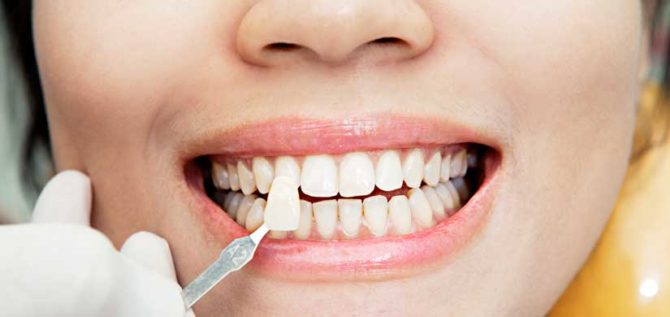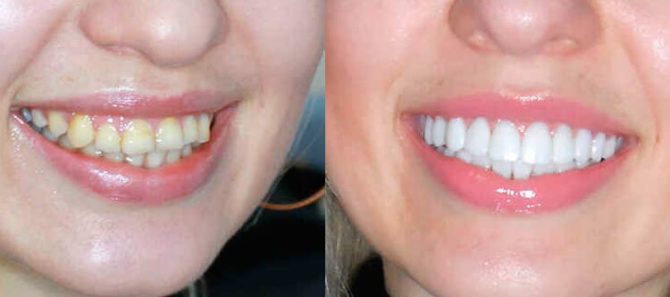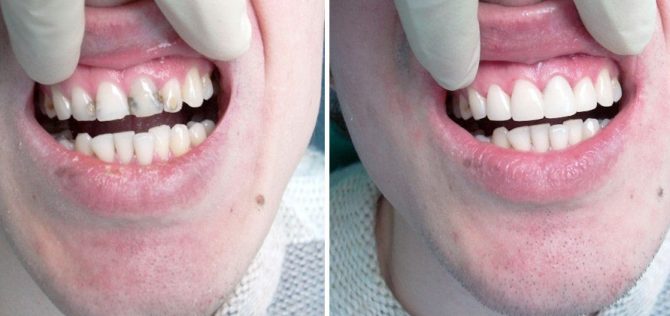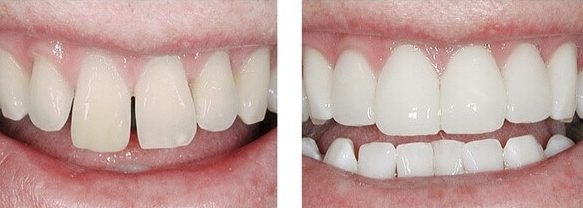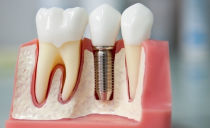What are veneers on teeth: types, advantages and disadvantages
To correct defects in the appearance and chewing function of the teeth, various prostheses are used: crowns, bridges, implants, veneers. In many cases, it is better to put veneers. They, like crowns, can be made of different materials and are fixed in various ways of fixing. But the size of these micro prostheses is smaller, and they cover only the front surface of the tooth.
Content
Indications for installing veneers
Dental veneers are microprostheses that, when properly installed, look like natural teeth. They are used if the appearance and shape of the dentition cannot be corrected by other methods, most often so restore teeth to the fifth in a row from above and to the fourth from below.
The process of creating overlays and their installation is very short, and even for the highest quality models does not exceed 1 week.
Veneers serve for a long time: according to statistics, after 16 years of wearing, microprostheses remain intact in more than 70% of patients.
Indications for prosthetics with veneers are:
- Excessive yellowness of enamel, including "tetracycline teeth", which turned yellow due to the side effects of the antibiotics taken.
- Enamel with signs of fluorosis.
- Unaesthetic appearance of enamel after depulpation.
- Irregular anatomical shape or incorrect position of the tooth: rotation around the axis, increased interdental spaces or crowding.
- Fillings on the visible part of the dentition, which differ in color from the natural shade.
- Improving the aesthetics of the dentition, in other words - creating a "Hollywood smile."
- Correction of defects not amenable to other restoration methods.
- Chipped tooth parts.
To the question of how many years it is better to put veneers, most dentists will give a single answer: at any age after adulthood. Micro dentures are not placed on milk teeth, and after 18 years there is a natural alignment and the formation of a bite.
Which prosthetics method to choose
If a person has defects in the dentition, the dentist may suggest that he restore, install braces, crowns or veneers. Each method has its own characteristics:
- For a snug fit of the artificial crown, the teeth grind on all sides and very deeply. But crown prostheses can fix a defect on either side of the tooth surface.
- When installing the veneer, only the thinnest enamel layer is grinded down, no more than 1 mm.
- If you need to align the dentition, the installation of braces will be a more effective way, especially since this method does not require strong grinding of the tooth surface.
- When aligning the lower or upper teeth with braces, the system is noticeable on the teeth, the metal braces of the old type look especially unaesthetic.
- Veneers with proper installation absolutely merge with the dentition.
- Restoration of teeth with light-polymer filling materials does not ensure the achievement of natural translucency of the tooth, therefore, the filled area can be very different from the surrounding dental tissue.
- Correction with veneers ensures the translucency of the surface, especially ceramic ones, since in composite products the appearance changes over time.
- Vinyl materials rarely cause allergies, which sometimes develops with other dental procedures.
Despite the fact that such properties of dental veneers often seem optimal, microprostheses also have disadvantages. There are situations when you should not install them.
Contraindications and disadvantages of veneering
Having learned about what dental veneers are, many people strive to make such prostheses in order to forget about defects in the dentition. But not everyone is suitable for vinyl, there are contraindications for it:
- Intensive abrasion of dental tissue.
- A predisposition to bruxism - nightly grinding of teeth.
- Malocclusion.
- Damage to the teeth on the inside or the presence of a large seal on the side of the tongue.
- Lack of many teeth.
- It is inappropriate to put any kind of veneers on the teeth of a person who has bad habits that lead to damage to prostheses: the habit of biting his nails or opening bottles with his teeth.
- Do not conduct veneering for athletes with frequent cases of damage to the dentition, for example, boxers.
The main disadvantage that is important for many patients is high cost of the procedure. When trying to choose a less expensive type of prosthesis, you have to “sacrifice” quality. Another minus - the strength of these pads is high enough, but can not provide absolute reliability.
An important nuance is the irreversibility of the procedure: if the appearance of the veneer is not satisfactory, or if it is damaged, it cannot be removed, you have to install a crown.
Types of veneers: which are better
For the manufacture of such micro prostheses, various materials are used that are practically indistinguishable in color from the patient’s natural, own teeth. The hue is selected in each case individually.
Modern dentistry offers:
- Ceramic veneers made of medical porcelain or zirconium dioxide. These microprostheses up to 0.5 mm thick are recognized as the best in strength and durability. They look like real teeth and do not lose their properties for a long time.
- Porcelain lumineers are the thinnest (about 0.2 mm) plastics made of porcelain, which are installed even without grinding teeth or on artificial crowns. Microprostheses of this type are used to achieve the perfect “Hollywood smile” effect.
- Composite veneers - prostheses made from composite materials that are prone to interact with certain components of food and drinks. By properties, they are not comparable with ceramic veneering, as they are short-lived and lose their aesthetic appearance over time. But their installation is simpler, often performed directly in the dentist’s office, and not in the dental laboratory. In fact, this type of veneer is a filling masking the front surface of the tooth.
The choice of veneers for teeth depends on the financial capabilities of the patient. If a person is willing to pay a sufficient amount for prosthetics, preference is given to ceramic veneers, less often to porcelain lumineers, their cost is highest. Budget option - veneering with composite prostheses.
Preparation for prosthetics
The first stage is a visit to the dentist to examine the oral cavity, identify defects, contraindications and direct indications for the installation of the prosthesis. If there are no obstacles for prosthetics, the doctor, together with the patient, chooses the material for the manufacture of veneers and a shade that should match the color of the teeth.
Before installing microprostheses, sometimes you have to grind your teeth for more tight contact between the surface of the crown and the vinyl plate. But when using lumineers, this procedure is optional.
Creation and installation of ceramic veneers
There are two methods of prosthetics with ceramics:
- The dentist layers the ceramic mass in layers, and then burns it, it turns out unpressed ceramics.
- The specialist performs the casting of the mass at high thermal and pressure values (pressed ceramics), this provides much greater strength and durability of the lining.
Zirconium linings are machined on special milling machines, this process is automatic.
The steps for installing ceramic microprostheses manufactured in a dental laboratory are as follows:
- Making a three-dimensional cast.
- Computer modelling.
- How many days elapses from tooth preparation to the installation of a permanent patch depends on the particular nuances, the material chosen, and the difficulty of prosthetics. Therefore, plastic temporary microprostheses are placed on the patient’s turned teeth, so that there is no discomfort in the oral cavity.
- Finished veneers are attached to pastes, which come in different shades. At this time, the patient and the dentist are finally determined with a hint of a micro prosthesis, since it strongly depends on the selected type of cement. Correct the shade after this stage will not succeed.
- The dentist sets the pad on a permanent microprosthesis, after which he is no longer being adjusted.
- The patient should check whether the lower and upper teeth are correctly joined with the veneers installed on them, whether the correct bite has formed.
Creation and installation of composite veneers
The properties of composite veneers depend on how they are made:
- Therapeutic composite pads are made by the dentists themselves in his office. Previously, they grind the tooth in front, and then apply layer-by-layer composite reflective material.
- The second method: the dentist grinds a tooth, makes an impression of a veneer, according to which an impression is created in the dental laboratory for its modeling. These are better and more expensive composite microprostheses.
Post Installation Actions
The doctor should tell the patient after installing the veneer what are the features of caring for them. About two weeks later, you should visit your dentist for a checkup the microprosthesis itself and the state of the surrounding tissues.
Some patients note that after correcting the appearance of the teeth become more sensitive. Despite this, they should be cleaned regularly, as standard hygiene rules suggest. But teeth with veneers cannot be pressured so that they do not deteriorate.
Particular care should be taken with prosthetic incisors, which bite off pieces of food. Especially with installed composite microprostheses, which are less durable. If the veneer has deteriorated, the dentist may suggest putting a crown on it. The same decision is made if the tooth under the veneer begins to decay.
If there is a desire to install veneers, it is worth contacting a good clinic in which qualified dentists work and using quality materials. An experienced dentist will advise which method of correcting the dentition is most suitable for the patient.

